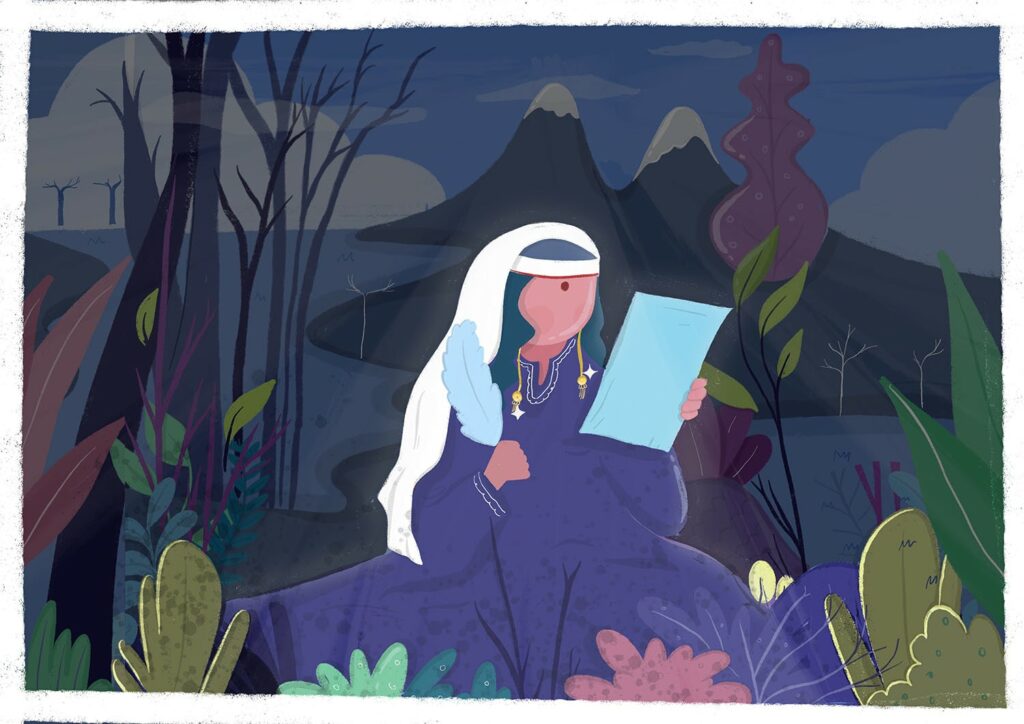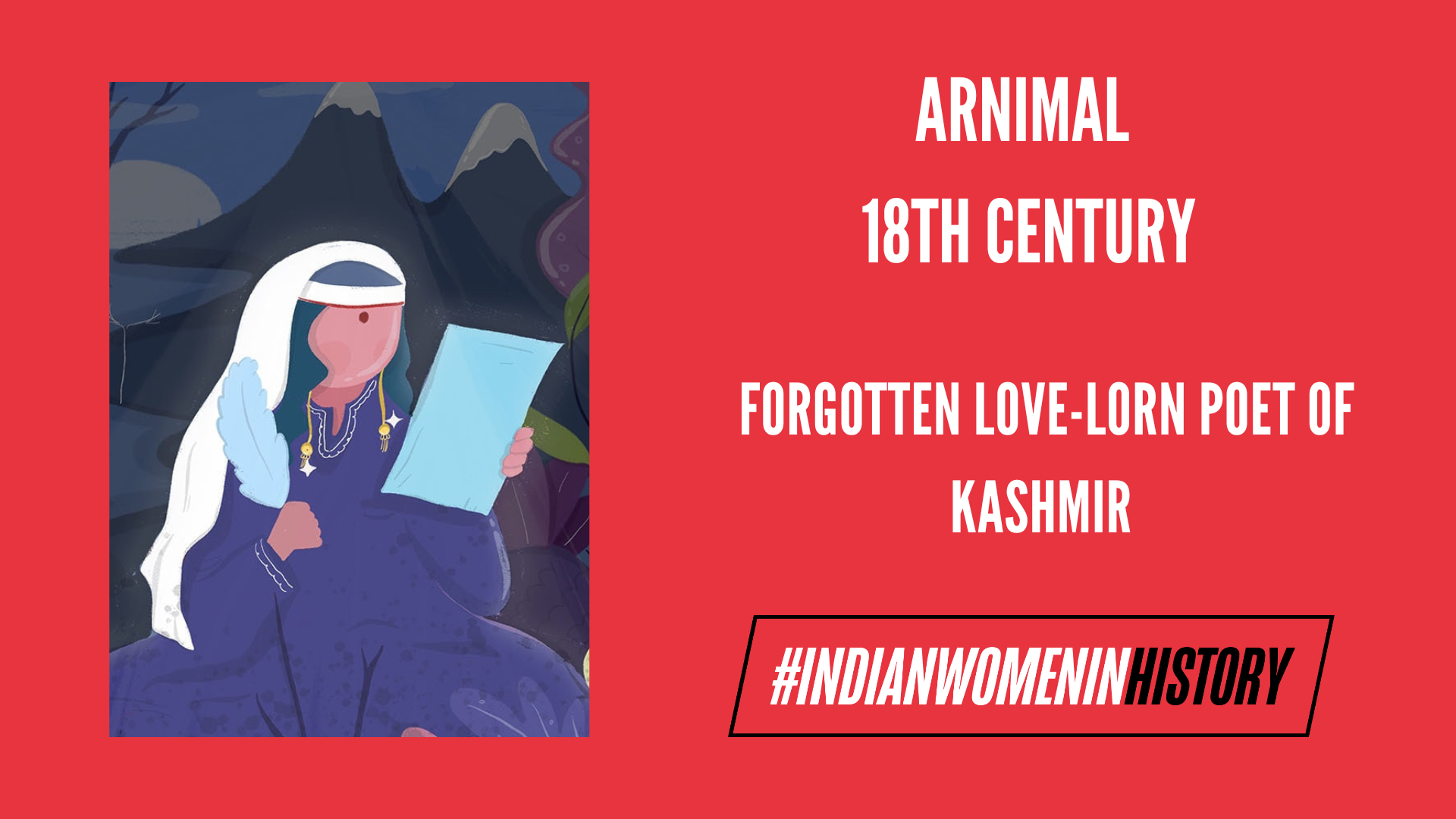In a landscape of drowned female voices, Arnimal shines. Writing mostly about heartbreak, isolation, rejection, and pain, the 18th-century Kashmiri poet’s strong imagery and personal voice have resonated with readers and literateurs in the subcontinent for centuries. While she was simply an ordinary woman writing about her life, quite typical of the time, she acts as a window into the 18th century, giving us a glance at the female experience of the time. Unfortunately, many of the rich details of Arnimal’s life have withered away due to the flow of time.
To this day, only about two dozen of her verses have been passed on from generation to generation by word of mouth. What remains paints a picture of her as a young woman who fashioned pens out of the chains of societal expectations and ink out of her tears.
Arnimal was born in Palhalan, near Srinagar, in 1737. Little is known of her childhood, but historians depict her as exuberant and creative. As the patriarchal custom at the time dictated, she married a higher-ranking man at a young age, moving far away to live with him. Her husband, Munshi Das Kachroo, never resembled the princes of the fairytales we grew up with. A poet and politician at the Afghan court, Kachroo spent his days busy as a member of the Afghan courts. Arnimal’s efforts for his affections went in vain.

As the years passed, Kachroo deserted Arnimal, leaving her to return to her parental home. Arnimal’s poetry hence holds three main themes.
1. As a deserted wife, Arnimal used her poetry to regain her husband’s affection. Given that her husband was also a poet in the Afghan court of Jumma Khan, his poetry was well-known at the time. Since his poetry was his mistress, Arnimal attempted to use the medium to draw attention back to herself, to make herself worthwhile in his eyes. This was unsuccessful, and Munshi Das Kachroo abandoned Arnimal, leaving her to return to her parental home.
Yet, Arnimal’s verses of longing outlasted his. Arnimal’s simple, love-lorn poetry survived the test of time, interweaving with Kashmiri folk music over the years and being renowned for their poignant depictions of love and longing.
“O, my love, You were the friend of my youth
Initially, I knew not how to value it
Wasted it away, Now I am pining and withering
Show me your countenance, I am dying for a mere glimpse
O, friend of my youth.“
2. Grief. As Arnimal returned to her parental home, her poems, while still about him, became the epitome of sorrow and grief. Her verses depict a woman scarred deeply by her husband’s rejection, and she spends the rest of her years writing about her pain. In a society where a woman’s worth was simply as a wife and as a mother, Arnimal had failed to fulfil these expectations. Her grief was insurmountable. Poetry acted as her outlet, and her verses after that period used metaphors and imagery to describe her anguish.
3. Nature. Arnimal describes the beauty around her, that she experienced in both her childhood and adulthood. Her poetry often uses metaphors of these natural artefacts around her, then not destroyed by the rapid industrialisation of today’s time. The flowers, shrubs and natural vegetation around her are frequent motifs in her poetry, giving her writing an earthy feel and tone.
Also Read: Habba Khatoon: The Greatest Poet And Peasant Queen Of Kashmir | #IndianWomenInHistory
Stylistically, Arnimal is known as an aficionado in the vatsun genre, invented 200 years ago by Habba Khatoon. Derived from the Sanskrit “vachan”, meaning word or speech, vatsun has no particular rhyme or verse scheme. Considered the predecessor to contemporary ghazals or the Western iambic pentameter, vatsun usually follows a stanza of around three lines before a repeating refrain. The vatsun is a natural transition from the earlier vaakh, popularised by Lal Ded, another female Kashmiri poet. With her use and popularisation of the vatsun genre, Arnimal places herself firmly in a long line of Kashmiri poets, primarily female, who created the literary history of the region.
Arnimal’s legacy is unchallenged in its groundbreaking nature. In popular folklore, she is known as the inventor of the santoor, the 100-stringed instrument central to later Indian music, but there is no compelling evidence to back up this narrative. While Arnimal’s poetry has stood the test of time, very little of her writing has survived the historical upheavals since her death. Very few of her poems remain, some in the form of ghazals and songs painstakingly transcribed by scholars on the subject.
Meanwhile, a descendant of Kachru speaking to Professor J.L. Kaul claimed that some of Arnimal’s salvaged poetry had been buried to protect it from Afghan invaders. While the well is still present in Srinagar, it is unclear what exists within it.
While historical records of Arnimal’s poetry are scarce, they are not insufficient. Yet, some believe that Arnimal did not exist at all. Mr Amin Kamil, for instance, announced on Srinagar Radio in 1998 that Arnimal’s existence was a myth, despite contradiction by several scholars on the subject. While much of Arnimal’s life is a mystery, it is clear that she existed, she loved, and she wrote, and any attempt to erase her from the nation’s history is blatantly misguided.
The poetry of any Kashmiri woman, in this case, Arnimal, cannot be considered without considering the context at the time of authorship. As Miriam Schnier points out, “Centuries of slavery do not provide fertile soil for intellectual development and expression.”
Also Read: Lal Ded: The 14th Century Mystic Poet Of Kashmir | #IndianWomenInHistory
There are striking similarities between the lives and poetry of Kashmiri literature’s three stalwarts: Habba Khatoon, Lal Ded, and Arnimal. They were all women, married before adulthood and facing tumultuous marital discord. It must be concluded that their poetry is especially poignant, having survived the centuries since. It must also be assumed that we have lost centuries of female poets to time and oppression, with their writing either forgotten by time or never allowed to develop. Arnimal, then, is one of the thousands of women who documented their lives in the 18th century. She is the only one we get to hear, and what she has to say is indispensable.
Also Read: Sugandha Devi: The Queen of Kashmir’s Golden Era
To compare the stalwarts of Kashmiri poetry would be to do a disservice to their legacy. Lal Ded, Habba Khatoon, and Arnimal are all women who have defined the landscape of Kashmiri literature, and none of their contributions outweighs the others’. However, it is fascinating to analyse the similarities and differences in their poetry and how they influenced each other. Lal Ded, the oldest known Kashmiri poet, wrote about mysticism and religion, inspired by the interlocking religions and cultures in Kashmir at the time. Habba Khatoon and Arnimal, meanwhile, were the first two romantic poets, both writing in the lyrical loal style. All three women were married at a young age and faced significant tragedy in their lives. Their poetry reflected this raw pain in their hearts and hence survived to this day.
The reasoning behind the survivorship bias tells us this: the parts of history that survive conquest are the strongest. If this is true, Arnimal and her poetry have proven themselves, time and again, to be an unshakeable tree against the winds of patriarchy, conquest, historical revisionism, and plain gender inequality. The timeless nature of Arnimal’s poetry and its longevity are hence evidence enough of the quality of her voice and the strength of her legacy.






